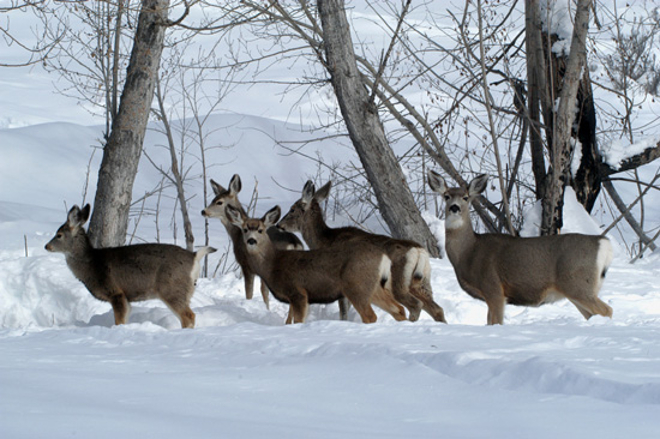|
IDFG ready to feed big game if needed |
|
January 5, 2017 |
 |
By Roger Phillips
IDFG Public Information Specialist
Big game animals are congregating at low
elevations, including near towns and homes after
December snow and some frigid temperatures
blanketed much of Idaho.
Some people are concerned about animals
surviving through winter, but so far, Fish and
Game has only started emergency feeding in
Eastern Idaho where a wildfire last summer
burned much of the available forage. Fish and
Game is also feeding in the Wood River Valley to
keep elk away from the highway and to reduce
damage to agriculture operations.
Fish and Game officials share the public’s
concern about the well being of deer and elk
populations during rough winters.
“We are watching snow conditions closely and our
regional wildlife program staff are in close
communication with their regional citizen winter
feeding advisory committees to assess where and
when it is appropriate to initiate feeding
operations,” said Jon Rachael, state wildlife
game manager.
Winter can be tough on big game animals, and
people can help them by leaving them alone.
Animals have a limited amount of fat reserves,
and when those are gone, animals are more
susceptible to disease, predation and
starvation.
Fish and Game has winter feeding guidelines to
separate normal big game mortality from extreme
mortality brought on by unusually harsh winters.
To start winter feeding, Fish and Game declares
an emergency based on environmental and
biological conditions while working in
consultation with regional winter feeding
advisory committees.
“We have feed pellets stored at locations around
the state where we most commonly feed, and we
are ready to initiate feeding operations if that
determination is made, and we are prepared to
order additional feed and supplies if
necessary,” Rachael said.
Advisory committees provide timely information
to regional Fish and Game supervisors so each
can decide if emergency winter conditions exist.
Advisory committees and Fish and Game officials
monitor snow depth, temperatures and quality of
forage on winter range.
Prolonged extreme weather, such as five
consecutive days when temperatures remain below
zero degrees, snow depths deeper than 18 inches
on south facing slopes, and other conditions,
can trigger emergency feeding.
Fish and Game has a long-standing policy to
manage big-game herds at levels that natural
habitat can support, and herds have grown in
recent years thanks to mild-to-moderate winters.
"We try our best to manage wildlife populations
at a level that can be supported by natural
habitat without the need for supplemental
feeding under normal conditions," Rachael said.
"But under severe conditions when natural forage
is unavailable because of snow depths, or
impacts from wildfire, and it appears
significant portions of a herd may succumb, we
are prepared to provide some extra help to
prevent large losses."
Even if winter conditions turn out to be normal
in terms of average temperature and snowfall,
some animals won’t make it. On average, about 50
percent of fawns die during winter, and about a
third of the elk calves. Adult survival for deer
and elk is typically more than 90 percent. It’s
nature’s way of ensuring the hardiest, fittest
animals survive and pass their genes to the next
generation.
"We realize we cannot help every deer and elk
through a tough winter, and not all animals will
benefit from supplemental feeding, but we do our
best to provide food to attempt to prevent major
losses," Rachael said.
Fish and Game officials also closely monitor
more than 900 deer and elk wearing radio collars
across the state, and will respond based on
information passed along daily from the radio
collars.
If winter conditions worsen dramatically and
emergency criteria are met, Fish and Game is
prepared to respond quickly to help struggling
big game.
“Monitoring 900 or more deer and elk will not
only provide a daily update on welfare of the
herds, but it also gives us scientific
information on survival through the entire
winter,” F&G's deer and elk coordinator Craig
White said. “Especially in places where there
are no people to provide information about the
animals.”
More information can be found on the
IDFG winter big game feeding page. |
|
Questions or comments about this
article?
Click here to e-mail! |
|
|
|
|

